|
|
JAMES BOND FACT FILES |
|
|
JAMES BOND FACT FILES |
|
||||||
 |
||||||
|
KEVIN HARPER takes a fascinating look at the American debut of Ian Fleming's James Bond novels in the 1950s and 1960s. As the US publishing rights were originally held by different companies, it was not until 2002 when Penguin Books re-issued the novels in paperback that collectors could own the complete series with uniform covers. Often censored for their US release, Ian Fleming's James Bond novels did not initially sell in large numbers; but with an endorsement from none other than the American President, and the release of the early films starring Sean Connery, the author eventually achieved the huge success that endures to this day. |
||||||
|
|
||||||
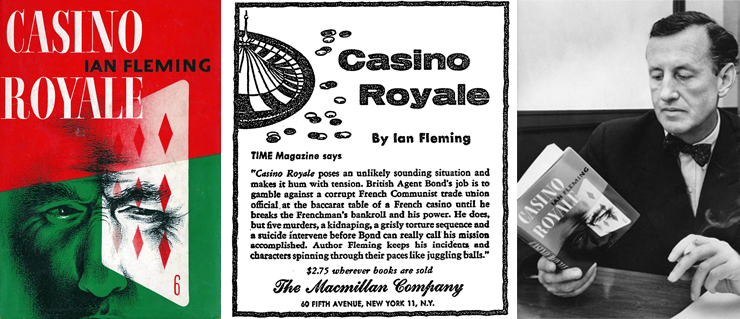 |
||||||
|
Leo Manso would also design the dust jackets for LIVE AND LET DIE and MOONRAKER, both published by Macmillan in 1955. In 1961 Manso would return to design their first omnibus edition Gilt-Edged Bonds, featuring Richard Chopping's superb illustration which appeared on the Jonathan Cape UK hardback edition of THUNDERBALL. The blurb on the rear of the CASINO ROYALE dust jacket took considerable artistic licence when describing the success of Fleming's first Bond novel proclaiming it was “... an immediate sensation in England, where more than 10,000 copies were snapped up within the first week of publication...”. In truth it would take six years for UK sales to reach that number and no more than 8,000 copies had been printed at the time the US edition was published. |
||||||
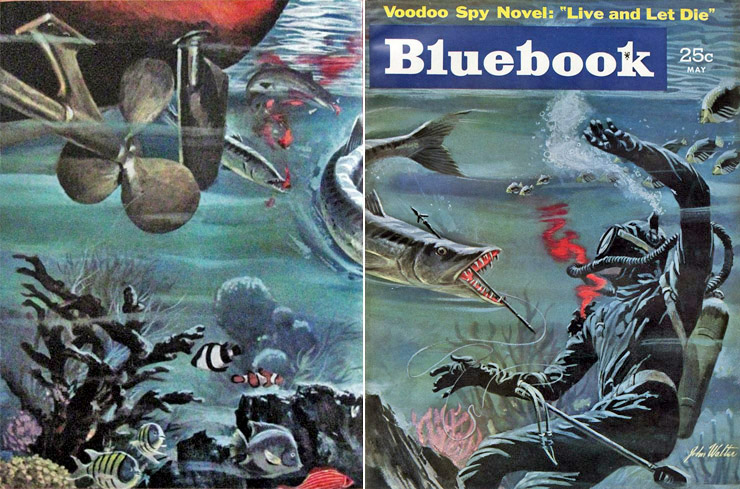 |
||||||
|
An abridged version of Ian Fleming's second James Bond novel originally appeared in the long-running American monthly magazine Bluebook in May 1954, a few weeks after its UK hardback debut. The wraparound Bluebook cover was illustrated by John Walter (1907-1987), with LIVE AND LET DIE promoted as a ‘Voodoo Spy Novel’. Herbert Saslow provided two illustrations to accompany the text. April 1955 then saw the hardback publication of LIVE AND LET DIE by Macmillan in a censored edition which renamed the original chapter five ‘Nigger Heaven’ to ‘Seventh Avenue’ for the US version. Changes were also made to some of the dialogue between negroes in this chapter, and other minor amendments throughout the novel to correct small geographical errors. Ironically the noted US novelist Raymond Chandler, who had recently struck up a friendship with Ian Fleming, had particularly praised the authenticity of the novels’ American scenes. Macmillan's editor Al Hart had also earlier made slight amendments to CASINO ROYALE in order to tone down Bond's seduction of Vesper Lynd. The uncensored versions would not be published in the USA until 2002 when Penguin Books issued the Fleming novels in paperback with new covers by Richie Fahey and Roseanne Serra. |
||||||
|
||||||
|
With CASINO ROYALE only selling a mere 4,000 hardback copies in the United States, when the paperback rights were acquired by The Popular Library they feared that American readers would not be able to pronounce ‘Royale’, so the book was re-titled You Asked For It. The pulp paperback was published in April 1955 and aside from the name Ian Fleming on the cover (with the original title in brackets), there is nothing to distinguish it as a James Bond novel. Selling for just 25c, You Asked For It would not have looked out of place amongst dozens of other trashy detective novels available at news-stands in the mid-fifties. In an attempt to Americanize Fleming's hero, he is named Jimmy Bond on the rear cover. ‘Card-sense Jimmy Bond’ (played by Barry Nelson) had already appeared in the USA when CBS television adapted CASINO ROYALE into a one-hour live drama transmitted on October 21, 1954. The live broadcast was presumed lost until a Kinescope recording was discovered in the early 1980s. James Bond's inauspicious small-screen debut did little to boost sales of Ian Fleming's novels in the US where they sold in very small numbers compared to the rest of the world. |
||||||
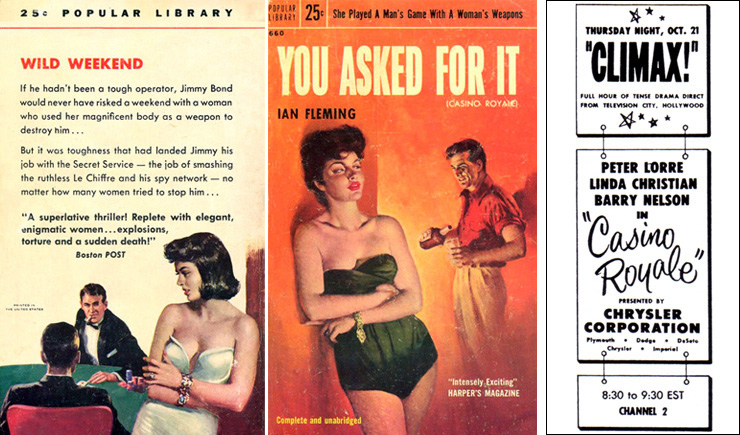 |
||||||
|
The publication of LIVE AND LET DIE by Perma Books in June 1956 actually marked the first printing of the novel in paperback. The UK paperback did not appear until October 1957, when it was published out of sequence in order to avoid competition with a hardback edition produced by The Reprint Society. The US paperback had striking cover artwork by James Meese (1917-1971), and in 2008 his original painting was displayed in the centenary exhibition ‘For Your Eyes Only: Ian Fleming and James Bond’ at the Imperial War Museum in London. Perma Books’ paperback of LIVE AND LET DIE barely sold 5,000 copies in the USA in 1956. |
||||||
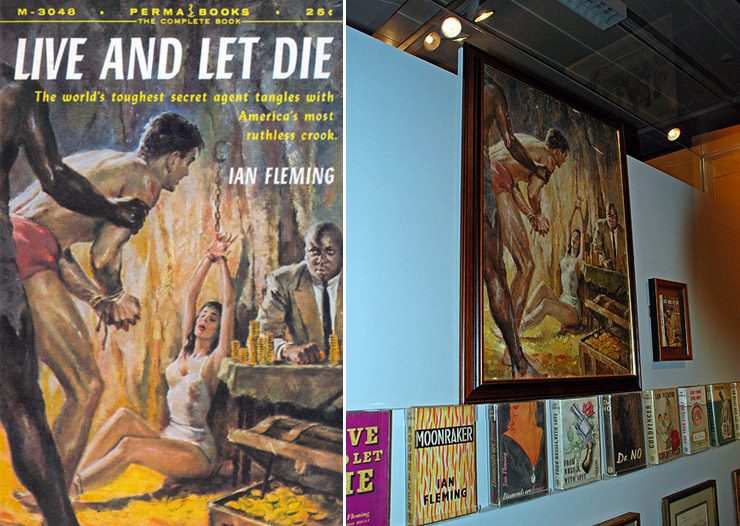 |
||||||
|
For the next hardback release Macmillan chose prolific paperback artist H. Lawrence Hoffman (1911-1977) to design the cover. Hoffman worked in many styles illustrating over 600 paperback covers for 25 publishing houses in New York. From 1941 to 1951, he was an Art Director and Partner at Immerman Art Studios and during this time illustrated many titles for The Popular Library, who had published You Asked For It (CASINO ROYALE) in paperback in the US. Published in October 1956, Hoffman's DIAMONDS ARE FOREVER cover featured an illustration of a severed human hand holding ten diamonds in its palm. A clever advertisement appeared in the New Yorker magazine promoting the release of the novel stating ‘A woman is a sometime thing.... but DIAMONDS ARE FOREVER’. The slogan ‘a diamond is forever’ was coined by De Beers jewellers in 1947, and the Macmillan advertisement paired this with the title of a song from George Gershwin's 1935 opera Porgy and Bess. For the US edition of DIAMONDS ARE FOREVER Macmillan changed the title of Chapter Four from ‘What's This All About?’, to the more American ‘What Goes On Around Here?’. |
||||||
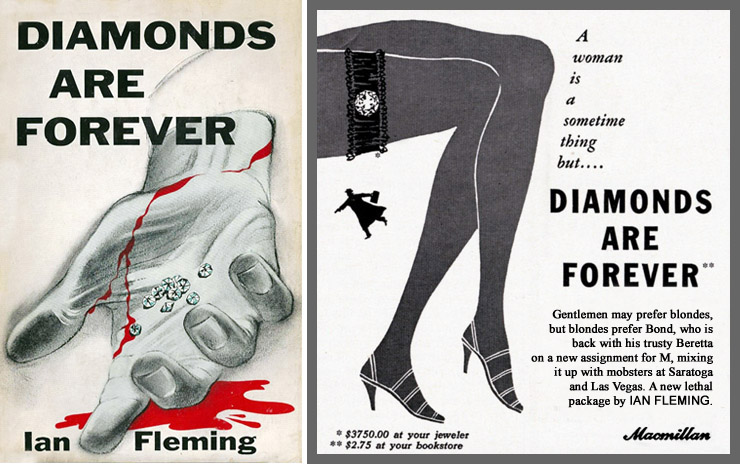 |
||||||
|
||||||
|
Perma Books then published DIAMONDS ARE FOREVER in paperback in November 1957, this time retaining the original title and featuring a striking cover illustration by William Rose (1909-1972). Rose had earlier provided the poster artwork for many celebrated RKO films of the 1940s including Citizen Kane (1941), Cat People (1942), The Body Snatcher (1945) and Out Of The Past (1947). |
||||||
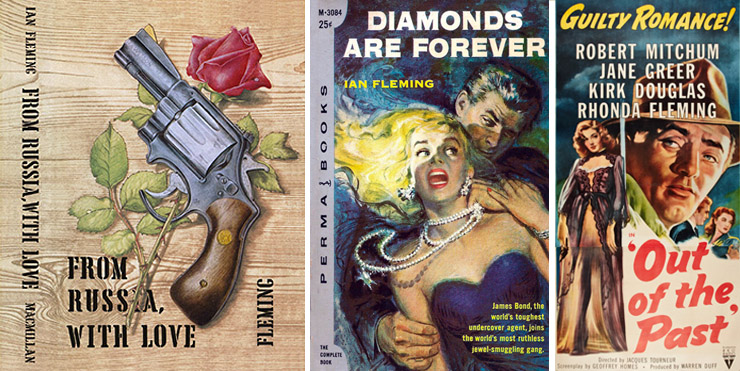 |
||||||